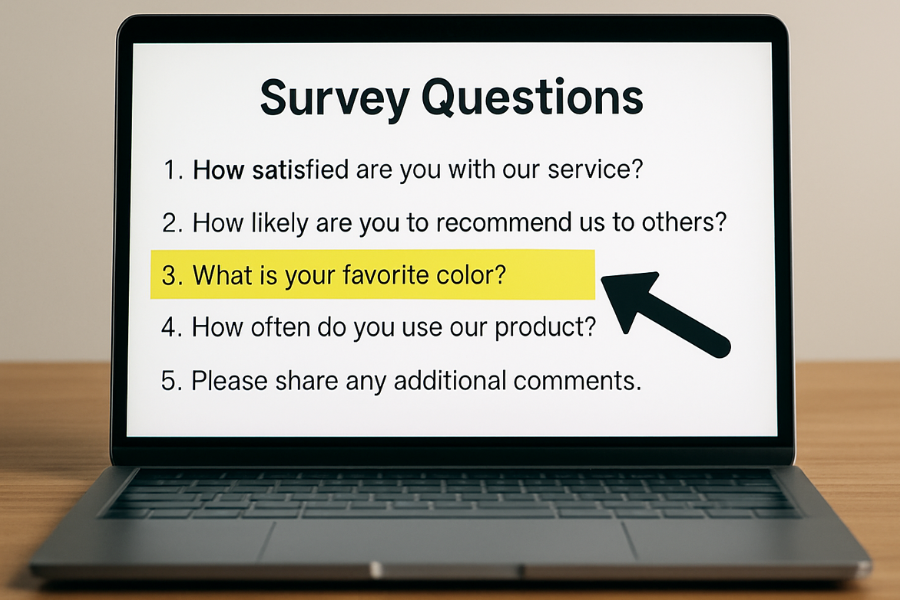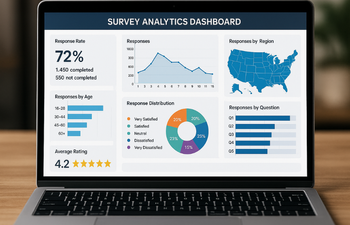Unlocking Growth: The Power of a Single NPS Survey Question
Discover how a single NPS survey question can drive customer loyalty, retention, and long-term business growth.

Introduction
Understanding customer satisfaction has always been the backbone of business success. In an era dominated by data, feedback loops, and user reviews, the Net Promoter Score (NPS) stands tall as a simple yet powerful metric. What's truly compelling is that this entire system hinges on a single, elegantly straightforward question:
"How likely are you to recommend our product/service to a friend or colleague?"
This one question has become a cornerstone in modern customer experience strategies, bridging the gap between raw feedback and strategic action. But how can a single question hold so much power? Let's explore the depth, versatility, and strategic edge of the NPS survey.
What Is NPS and Why Does It Matter?
The Net Promoter Score is not just a number. It's a reflection of customer trust, satisfaction, and loyalty. It quantifies the likelihood of customers acting as brand ambassadors or critics. But unlike traditional surveys that bombard users with endless queries, NPS simplifies the approach, boosting participation and sincerity.
If you're looking to build your own survey from scratch, our step-by-step guide How to Create an Online Survey will help you get started with best practices and actionable tips.
The Structure of the NPS Survey Question
At the core of every NPS survey is a 0–10 scale. Respondents are asked to rate their likelihood to recommend your offering, and based on their answers, they fall into three categories:
- Promoters (9–10): Loyal enthusiasts who are likely to refer others and fuel growth.
- Passives (7–8): Satisfied but unenthusiastic customers vulnerable to competitive offers.
- Detractors (0–6): Unhappy customers who may damage brand reputation through negative word-of-mouth.
The final NPS score is calculated as:
% Promoters − % Detractors = NPS
The Psychology Behind the Single Question
This question taps into the emotional connection and experience a customer has with your brand. Rather than asking "Are you satisfied?", which is vague and difficult to act on, NPS questions if they'd actively vouch for you. That’s a leap from being content to being loyal.
Simplicity Drives Higher Engagement
Long surveys are a turn-off. With attention spans decreasing and inboxes flooded, a single-question survey is a breath of fresh air. It respects the customer’s time while collecting powerful feedback, leading to much higher response rates.
Real-Time Feedback Collection
NPS surveys can be deployed via email, within apps, or post-purchase. The single-question format allows businesses to collect insights continuously and in real-time, building a live pulse of customer sentiment.
Actionable Segmentation Through NPS
By segmenting customers into promoters, passives, and detractors, businesses can tailor their strategies more effectively:
- Engage promoters with referral programs or loyalty rewards.
- Convert passives by improving areas of dissatisfaction.
- Win back detractors with personal outreach and resolution tactics.
The Strategic Impact of Promoters
Promoters are your brand's hidden sales force. Studies show they are more likely to return, spend more, and refer others. Understanding what drives their loyalty can help you replicate that experience across your customer base.
Turning Detractors Into Advocates
While it might feel discouraging to hear negative feedback, detractors provide gold for improvement. With the right follow-up, transparency, and resolution, many detractors can be converted into brand advocates.
NPS as a Predictor of Growth
Research by Bain & Company, the creators of the NPS framework, suggests that companies with higher NPS scores tend to outperform their competitors in growth metrics. It’s not just a customer service tool, it’s a growth engine.
Linking NPS to Revenue
Improving your NPS by even a few points can lead to significant revenue gains. Loyal customers not only spend more but also bring in others, reducing acquisition costs and boosting customer lifetime value.
Benchmarking NPS Across Industries
Understanding where you stand in your industry helps identify realistic goals and growth opportunities.
When and How Often to Send NPS Surveys
The timing of NPS surveys matters. Consider sending:
For more ideas on timing and context, especially around events, see Event Feedback Surveys: What to Ask Before, During & After for practical advice on maximizing feedback opportunities.
- Immediately after a customer interaction (transactional NPS)
- On a regular schedule, e.g., quarterly (relational NPS)
- Post-onboarding or after milestone achievements
Best Practices for Following Up
Collecting the score is only half the job. Effective NPS programs include follow-ups to thank promoters, gather insights from passives, and resolve issues with detractors. A good follow-up strategy can amplify the power of NPS tenfold.
Enhancing Product Roadmaps with NPS
Customer feedback often points to feature requests, UX friction, or missing elements. Using NPS comments to guide product development ensures the roadmap aligns with actual user needs.
Internal Alignment Through NPS
NPS acts as a shared metric across departments, from marketing to customer support to product. It fosters alignment and shared responsibility for improving the customer experience.
Using NPS for Customer Retention
Retention strategies rooted in NPS insights are more effective because they are based on actual customer sentiment, not assumptions. This leads to personalized outreach and stronger relationships.
Automating NPS Collection and Analysis
Leverage tools like Delighted, Promoter.io, or Hotjar to automate survey sending and response analysis. Integration with CRMs can enrich your customer data and inform lifecycle marketing.
Overcoming Limitations of NPS
While powerful, NPS is not perfect. It doesn’t explain why customers feel a certain way. Pairing it with open-ended feedback collection helps address this limitation and reveals deeper insights.
The ROI of a One-Question Survey
The minimal investment required to deploy a single NPS question yields disproportionately high returns, in data, loyalty, and strategic clarity.
Case Studies: Growth Fueled by NPS
Consider Apple, who pioneered the use of NPS in retail to fine-tune customer service, or Airbnb, which uses it to refine both host and guest experiences. These companies prove the power of NPS to impact growth directly.
Building an NPS Culture
The goal isn't just to measure, it’s to act. Building a company culture that values feedback, celebrates promoters, and learns from detractors ensures NPS becomes more than a number.
The Future of NPS: AI, Predictive Analytics, and Beyond
AI tools can now predict NPS scores based on behavior and usage patterns, enabling proactive interventions. The fusion of machine learning with NPS is reshaping how companies understand loyalty.
Conclusion
The elegance of the Net Promoter Score lies in its simplicity. With just one question, you can uncover deep truths about your customer base, drive strategic decisions, and unlock meaningful growth. It's not about measuring satisfaction, it's about creating promoters, learning from detractors, and delivering experiences that build lasting loyalty.
Frequently Asked Questions
Find answers to the most common questions about this topic
An NPS (Net Promoter Score) survey is a tool used to measure customer loyalty by asking how likely a customer is to recommend your product or service on a scale from 0 to 10.
A single question keeps the survey short and focused, increasing response rates while still providing actionable insights into customer satisfaction and loyalty.
Businesses can identify promoters who are loyal and likely to advocate for the brand, detractors who may harm the brand’s reputation, and passives who could be turned into loyal customers with the right actions.
NPS is calculated by subtracting the percentage of detractors (0–6 ratings) from the percentage of promoters (9–10 ratings).
Yes, by analyzing feedback from detractors and passives, businesses can pinpoint areas of dissatisfaction and prioritize product or service enhancements.
Yes, NPS is widely used across various industries including SaaS, eCommerce, healthcare, finance, and more, as it provides a universal measure of customer sentiment.








